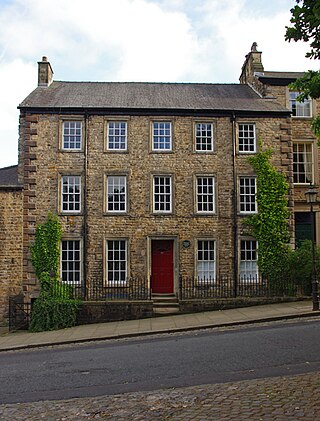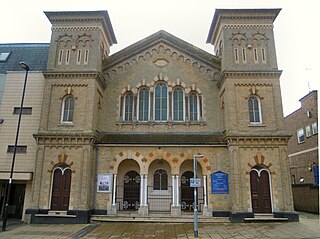
Cartmel Priory church serves as the parish church of Cartmel, Cumbria, England.

Edward Graham Paley, usually known as E. G. Paley, was an English architect who practised in Lancaster, Lancashire, in the second half of the 19th century. After leaving school in 1838, he went to Lancaster to become a pupil of Edmund Sharpe, and in 1845 he joined Sharpe as a partner. Sharpe retired from the practice in 1851, leaving Paley as the sole principal. In 1868, Hubert Austin joined him as a partner, and in 1886, Paley's son, Henry, also became a partner. This partnership continued until Paley's death in 1895.

Sharpe, Paley and Austin are the surnames of architects who practised in Lancaster, Lancashire, England, between 1835 and 1946, working either alone or in partnership. The full names of the principals in their practice, which went under various names during its life, are Edmund Sharpe (1809–77); Edward Graham Paley (1823–95), who practised as E. G. Paley; Hubert James Austin (1841–1915); Henry Anderson Paley (1859–1946), son of Edward, usually known as Harry Paley; and, for a very brief period, Geoffrey Langshaw Austin (1884–1971), son of Hubert. The firm's commissions were mainly for buildings in Lancashire and what is now Cumbria, but also in Yorkshire, Cheshire, the West Midlands, North Wales, and Hertfordshire.

Lewes Free Presbyterian Church, based in the Jireh Chapel, is one of seven Free Presbyterian Church of Ulster places of worship in England. The Jireh Chapel is a former Calvinistic Independent chapel in the Cliffe area of Lewes, the county town of East Sussex and the main town in the local government district of Lewes. It is more than 200 years old and has been designated a Grade I Listed building.

St. James Church located on Blake Street in Barrow-in-Furness, belongs to the Church of England's Diocese of Carlisle within the ecclesiastical Province of York. The present church building dates from the mid-19th century and is Grade II* listed.

St Mary of Furness is a Roman Catholic church located on Duke Street in Barrow-in-Furness, England. The congregation was founded in 1858, however the current building was constructed between 1866 and 1867. It is a Grade II listed building.

Trinity Congregational Church, later known as Union Chapel, is a former place of worship for Congregationalists and Independent Christians in Arundel, an ancient town in the Arun district of West Sussex, England. Protestant Nonconformism has always been strong in the town, and the chapel's founding congregation emerged in the 1780s. After worshipping elsewhere in the town, they founded the present building in the 1830s and remained for many years. Former pastors included the poet George MacDonald. Robert Abraham's distinctive neo-Norman/Romanesque Revival building was converted into a market in the 1980s and has been renamed Nineveh House. The church is a Grade II Listed building.

St. George's Church is in St George's Square, Barrow-in-Furness, Cumbria, England. It is the oldest active Anglican parish church in the town. The church is in the deanery of Barrow, the archdeaconry of Westmorland and Furness, and the diocese of Carlisle. Its benefice is united with those of St Aidan, Newbarns, St Luke, Risedale, and St Perran, Roose, to form the South Barrow Team Ministry. The church is recorded in the National Heritage List for England as a designated Grade II listed building. It stands at the southeast extremity of the town.

Holy Trinity Church is in the village of Seathwaite, Cumbria, England. It is an active Anglican parish church in the deanery of Furness, the archdeaconry of Westmorland and Furness, and the diocese of Carlisle. Its benefice is united with those of four other local parishes. The church is recorded in the National Heritage List for England as a designated Grade II listed building.

Ulverston Parish Church is in Church Walk, Ulverston, Cumbria, England. It is an active Anglican parish church in the deanery of Furness, the archdeaconry of Westmorland and Furness, and the diocese of Carlisle. Its benefice is united with that of St John, Osmotherley. The church is recorded in the National Heritage List for England as a designated Grade II* listed building.

The Furness Abbey Hotel was demolished in 1953, having been bombed in May 1941. Its site now forms the car park to Furness Abbey and the museum. The station at Furness Abbey also suffered bomb damage and was demolished in the early 1950s. The original station booking office and refreshment room, built in 1862, which had been attached to the hotel, survives as The Abbey Tavern, standing in Abbey Approach, Barrow-in-Furness, Cumbria, England, to the north of the remains of Furness Abbey. The current structure is recorded in the National Heritage List for England as a designated Grade II listed building.

St Mary the Virgin's Church is located on the Promenade, Walney Island, Barrow-in-Furness. Cumbria, England. It is an active Anglican parish church in the deanery of Barrow, the archdeaconry of Westmorland and Furness, and the diocese of Carlisle. The church is recorded in the National Heritage List for England as a designated Grade II listed building.

St Matthew's Church is in St Matthew's Street, Burnley, Lancashire, England. It is an active Anglican parish church in the diocese of Blackburn. The original church was built between 1876 and 1879, and was designed by William Waddington and Sons. This burnt down in 1927 and was replaced by the present church. In the 1970s St Matthew's joined with the neighbouring Holy Trinity Church.

Abbot's Wood was a large country house and estate located to the north-northeast of Barrow-in-Furness, Cumbria, England. It was sited on elevated ground to the northeast of Furness Abbey. The house was surrounded by extensive grounds with footpaths providing fine views.
St. George's Square, in Barrow-in-Furness, Cumbria, England is a public space that acted as the centre of the town during the late 19th century. The square now lies in the southernmost fringes of the Central ward close to the Port of Barrow.

The English Presbyterian Church is the former Presbyterian church for Aldershot in Hampshire. Built in 1863 it served that denomination until 1972 when most churches in the Congregational Church in England and Wales and virtually all of the congregations of the Presbyterian Church of England including that at Aldershot combined to form the United Reformed Church in England. By the late 1970s the building was derelict at which time it was purchased by the New Testament Church of God (NTCOG) who worship there today.















